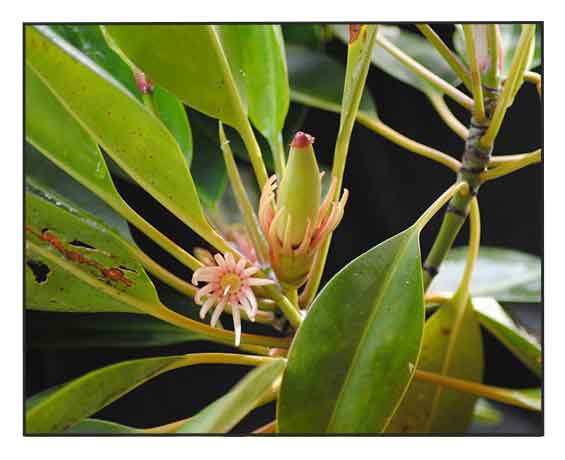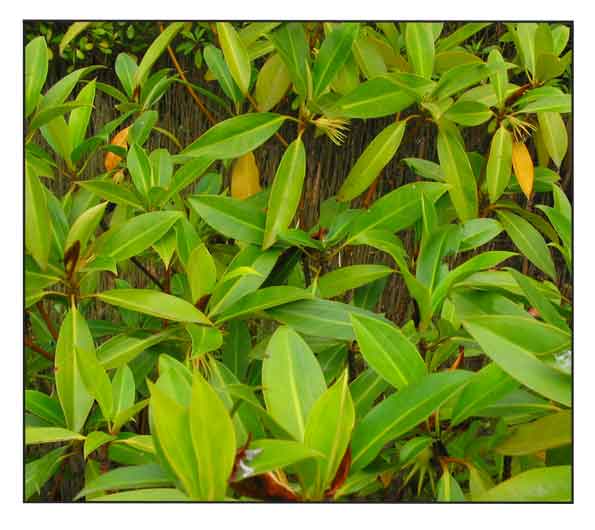 Gen info Gen info
- Bruguiera sexangula is the only Bruguiera species which sometimes form stilt roots. (1)
Botany
Bruguiera sexangula is a tree growing up to 33 m tall; trunk diameter up to 65-80 cm; buttresses up to 1 m high, tending to develop into plank-like non-arching stilt roots; pneumatophores knee-shaped, up to 45 cm long, forming horizontal and anchor roots. Bark smooth, greyish to pale brown with a few, large, corky lenticels, especially on the buttresses. Branching mostly sympodial. Leaves decussately opposite, elliptical to elliptical-oblong, rarely oblanceolate, 8-16 cm by 3-6 cm, pale green, entire, acute at both ends; petiole 1.5-5 cm long; stipules in pairs, 3.6-4 cm long, early caducous, green or yellowish. Flowers solitary, generally nodding, at anthesis 2.7-4 cm long; pedicel 6-12 mm long, green, yellow or brownish; calyx tubular with 10-12 lobes, yellow, yellow-brown or reddish, never bright red, tube 1-1.5 cm long, 2-lobed, whitish turning yellowish-brown, densely fringed with hairs along the outer margins, lobes half the length of the petal, each with a reflexed and obtuse apex bearing 1-3 bristles, up to 1.2 mm long and a distinct bristle in the sinus between the lobes; each petal embraces a pair of stamens; stamens 7-14 mm long; style filiform, 1.5-2.2 cm long, with 3-4 short branches. Fruit a berry, more or less distinctly ribbed, enclosed in calyx, 1.5-1.8 cm long; hypocotyl cigar-shaped, rather angular, 6-8 cm by 1.5 cm, with narrow blunt end. (1)
Distribution
- Native to the Philippines.
- Occupies inland parts of mangrove forests, which are not frequently submerged. May be found along river bank; occasionally on sandy shores. (1)
- Also native to Andaman Is., Bangladesh, Bismark Archipelago, Borneo, Cambodia, Christmas I., Hainan, India, Jawa, Lesser Sunda Is., Malaya, Maluku, Myanmar, New Guinea, Northern Territory, Queensland, Sri Lanka, Sulawesi, Sumatera, Thailand, Vietnam. (2)
 Constituents Constituents
- Phytochemical investigation yielded tannin, terpenoids, saponins, flavonoids, alkaloids, and anthraquinones in various plant parts. (see study below) (3)
- Phytochemical studies have yielded hydrocarbons, lipids, phenolic compounds, protein, steroids, alkaloids, tannins. (4)
- Crude alkaloid mixtures from the bark of B. sexangula and B. exaristata yielded tropine and tropine esters of acetic, propionic (a new natural ester), n-butyric (a new natural ester), isobutyric,
α-methylbutyric or isovaleric, and benzoic acids. The major component from both mixtures was the new alkaloid, brugine, (+)-tropine 1,2-dithiolan-3-carboxylate. (5)
- Study isolated a new cytotoxic lanostane-type triterpenoid, sexangulic acid (1)
. (6)
Properties
- Studies have suggest antioxidant, antibacterial, antitumor, antiviral properties.
Parts used
Fruit, root, leaves.
 Uses Uses
Culinary
- In Sulawesi, fruit is cooked, then soaked overnight before it is eaten.
- Bark provides food flavoring.
Folkloric
- Fruit applied to shingles.
-
Roots and leaves applied to burns.
- In India, juice from fruits used for treatment of sore eyes, shingles and burns.
(8)
Others
- Wood: Use as fuelwood; charcoal. Roots made into incense wood.
- Construction: Wood is moderately durable; used for poles and house construction. Used as fishing stakes.
- Bark: Bark yields tannin, flavoring, and an adhesive.
- Betel quid: In Malaysia and Indonesia, fruit sometimes used in the betel quid.
Studies
• Antioxidant / Leaves and Branches: Phytochemical investigation of Bruguiera sexangula and Connarus semidecandrus yielded tannin, terpenoids, saponins, flavonoids, alkaloids, and anthraquinones in various plant parts. Bruguiera sexangula leaf extracts yielded highest total phenolic content (467.7 mg GAE/g) followed by branches (443.4 mg GAE/g). Strongest free radical scavenging activity was exhibited by extracts of branches of B. sexangula with IC50 of 8.62 µg/mL (DPPH) and 167 mmol Fe2+ equivalent/gram extract of leaves by FRAP method. Results suggest methanolic extracts of B. sexangula could be a significant source of natural antioxidants. (3)
• Antitumor / Bark: Bruguiera sexangular bark extracts showed activity against two tumors, Sarcoma 180 and Lewis Lung Carcinoma (Loder and Russell, 1969). (4)
• Antibacterial / Leaf and Bark: Study evaluated the antibacterial activity of 75 plant extracts from mature leaves and bark of seven mangrove plants (Bruguiera sexangula, A. marina, A. officinalis, E. agallocha, L. racemosa, and R apiculata) against antibiotic resistant pathogenic bacteria, Staphylococcus aureus and Proteus sp. Ethyl acetate extracts of mature leaf, immature leaf and bark of Bruguiera sexangula exhibited antibacterial activity against S. aureus. All extracts showed more antibacterial activity against S. aureus than Proteus sp. (7)
• Mangrove Endophytes / Antiviral: Two of the anthraquinones obtained from Nigrospora sp. isolated from Bruguiera sexangula exhibited good prophylactic effects against human rhinoviruses. (8)
• Antioxidant / Flavonoid Content / Leaves: In a study of five mangrove species for antioxidant activity and flavonoid content, the methanol extract of B. sexangula showed highest yield. It yielded highest TPC (total phenolic content) with 64.28 ± 3.05 mg GAE/g) and showed excellent antioxidant contents. B. sexangula methanol and water extract showed highest TFC than other species, 37.90 ± 4.76 QE/g and 30.53 ± 0.01 mg QE/g, respectively. On DPPH assay, B. sexangula hexane extract showed 91,67% inhibition. (9)
Availability
Wild-crafted. |

![]()



 Gen info
Gen info Constituents
Constituents Uses
Uses